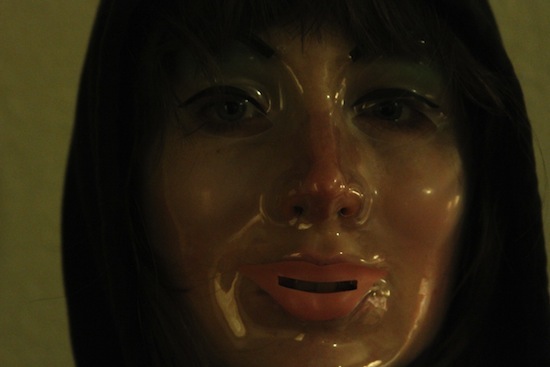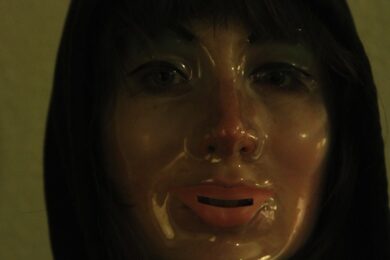I love a good portmanteau horror, I do. The tradition of getting a bunch of different directors together to tell separate stories linked by an overarching narrative – whether the shlocky Tales From the Crypt, jittery classic Dead of Night or misleadingly named Doctor Terror’s House of Horror (that’s not a ‘house’, Doctor, it’s a train) – brings the viewer that bit closer to the root of all horror tales: the story told round the campfire, each teller seeking to increase the fear factor as the cold night draws in. That said the format of such films almost invariably means that some stories just don’t cut the mustard. Take Dr Terror…'</i<, for instance: while I’m fully prepared to believe that Roy Castle is capable of harnessing the powers of Voodoo through his trumpet, I’m still not entirely convinced about Alan ‘fluff’ Freeman taking on Man eating plants and triumphing. The format can result in a generally a mixed bag then, but with V/H/S we have something out of the ordinary: a thoughtful, well-made and consistently interesting (not to mention, on occasion, pants-browningly frightening) horror anthology.
The basic gimmick is simple. All the stories are in the found-footage format, presenting a character’s view point through a portable camera, and are linked by the simple means of having a bunch of disreputable jocks in an old house looking for a particular VHS tape, watching them in turn in order to find the required footage and claim a cash reward. Where V/H/S takes off is in its original uses of the old hand-held gimmick. Sure, we’ve seen ghost stories and Godzilla-style monster mash-ups using the format, but what about feminist vampire tales, Lovecraftian hell rides and squamous body horror? All here and accounted for and given a patina of freshness by their presentation.
First, and for my money one of the most successful stories in the film, is Amateur Night by director David Bruckner. Based around the boorish antics of a group of sad-sack frat boys and their attempts to corral women into appearing in an amateur porn film, Bruckner leaves you in no doubt as to where his sympathies lie, as each jock in turn experiences a repulsive comeuppance. Not only is it one of the best stories in the film but it sets the tone for what follows, and is an original take on the vampire myth – a serious accolade in this world of Twilight domination and its slick, anaemic blood suckers.
Next up is Ti West’s Second Honeymoon, a tale of the misfortunes of two young lovers on the titular holiday through America. West’s House of the Devil was a fascinating, flawed take on 80s horror aesthetics, meticulously presented if at times a little dry, so seeing him take to the handheld and produce this quick, effective shocker provides an interesting look at his wider talents. Although there’s no supernatural antagonism in this story West manages to present us with a situation of escalating tension before turning all expectations on their head with a surprising, satisfying denouement. The story also works well in underlining the wider film’s feminist credentials. All the separate sections of V/H/S are a world away from the hooting fratboy idiocy of film makers like Eli Roth, proving that it’s possible to be scary and effective without merely finding the nearest female character, tying her to a chair and proceeding to blowtorch her eyes out.
Glenn McQuaid’s Tuesday The 17th is a fairly straight slasher in the woods with a twist set-up, but excels itself with an original and haunting antagonist that uses the limitations of the hand held format brilliantly, appearing simply as a harsh static blur on the camera and inviting speculation as to what exactly the main characters are fleeing. A supernatural presence? Some kind of stealth suited survivalist? The audience never know. But, hell, when there’s this much intestinal viscera being showered at the camera, who cares, right? Not me, by jingo, not me.
The Sick Thing That Happened to Emily When She Was Younger is Joe Swanberg’s effort and is one of the most original. All the action takes place during a couple’s Skype calls, as the girlfriend reports to her partner about strange occurrences in her house. Far from the Skype perspective being limiting, Swanberg uses it in ingenious ways to chart the protagonist’s mental dissolution and to cast doubts upon their motivations. The climax is surprising, nasty and completely overturns your ideas of what you’ve just been watching, leaving plenty of room for a second view.
Last and not least comes 10/31/98 from film making four piece Radio Silence. This is the straight up ghost train ride that the film has been missing up until now. A group of friends go into a house, find a satanic ritual (or exorcism, it isn’t quite clear) taking place and run away screaming, providing an opportunity for hands to shoot out of walls, people to be sucked howling into some qlippothic netherworld, flocks of birds to erupt at the camera for no good reason and the main characters (ironically the only straight up relatable ones in the whole film) to perish brutally. It’s a fantastic 20 minute heaping of ghoulish fun and brings the film to a juggernaut of a close.
All in all the only disappointment is that the linking sequences of the dudes hunting through the piles of VHS video cassettes are a bit confusing and add very little to the overall film, but this is a small gripe. Here’s a movie that allows you to check out a heap of fresh, independent talent, be thoroughly entertained and all the while stain your slacks with fright. Go and check it out with the honey of your choice this weekend. V/H/S is great VFM.



